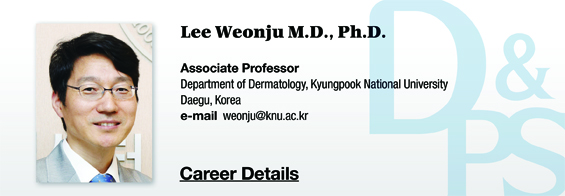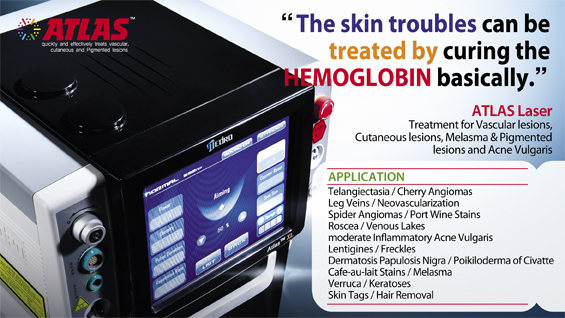▶ Previous Artlcle : #3-1. Cosmetic Products for Acne
Oral medication and various other treatments
Among oral medications of acne, isotretinoin has been traditionally known to be most effective. It is generally used in severe acne. Use in high doses causes various side effects and efforts are being made to maximize the efficacy of lower doses. Combination with azithromycin can reduce side effects and enhance the therapeutic effect. One major side effect of isotretinoin is suicidal ideation, whose association with this substance has recently been reported to be little. Isotretinoin has been reported to cause muscle damage or intestinal inflammation, however, more evidence is needed to make conclusions in this regard.
[Advertisement] ATLAS(Long pulse 532nm & 940nm dual wavelength) – Manufacturer: MEDRO(www.medro.net)
It is desirable to use oral antibiotics for only a short period of time due to the risk of resistant bacterial strain development. Oral antibiotics are used in combination with benzoyl peroxide or retinoid ointments. There is no evidence showing minocycline, one type of oral antibiotics, is more effective and safer than other antibiotics in the tetracycline class. The new extended release formulation with a higher price has not been shown to be safer than the standard formulation. Lymecycline is a more affordable tetracycline class antibiotic with less side effects.
Hormonal agents are suitable for female patients requiring contraception. Oral contraceptives containing combination of ethinyl estradiol with cyproterone acetate, desogestrel or drospirenone, etc. are used. These agents inhibit sebaceous gland function and reduce androgen secretion. However, progesterone alone is known to exacerbate acne. Low-dose prednisolone or dopamine may be used, whereas estrogen alone, spironolactone or flutamide, etc. are generally not used in acne.
As for chemical peeling agents, glycolic acid is widely used for its effect on comedone reduction and antibiotic action against P. acnes. Salicylic acid is also commonly used as a peeling agent.
Photodynamic therapy is one of the therapeutic modalities of acne. The light uses porphyrin as a photosensitizer to damage sebaceous glands and the glycocalyx coat of P. acnes. The red and blue light occasionally bring better outcomes than 5% benzoyl peroxide. Photodynamic therapy that irradiates red light beams after application of photosensitizers such as aminolevulinic acid (ALA) or methyl ALA brings noticeable improvement in noninflammatory acne. Especially, methyl ALA brings long-term inhibition of acne by destroying sebaceous glands. Photodynamic therapy that irradiates IPL after ALA injection has less side effects and prevents recurrence. Disadvantages of this modality are the lack of standardized methods and scientific data on long-term treatment. The 1320 nm Nd:YAG laser and 1450 nm diode laser affect sebaceous glands to reduce sebum secretion and improve acne.
Another novel treatment modality uses antimicrobial peptides such as epinecidin, granulysin, and omiganan which treat acne with antibacterial action.
Cosmetic products for acne
There are a myriad of acne-related cosmetic products in the market. As acne skin is sensitized and has weakened skin barrier, using a proper moisturizer is important for improvement and prevention of acne.
Cetaphil Dermacontrol Oilcontrol Foam Wash and Cetaphil Dermacontrol SPF30 Oilcontrol Facial Moisturizer released by Galderma are known to cause little irritation and provide ample moisturization. Cetaphil Dermacontrol Oilcontrol Foam Wash is a foam-type facial cleanser. It helps control excess sebum production in an acne-prone skin and soothes the troubled skin while minimizing skin irritation. It is a mild cleanser with an effective cleansing action. Active ingredients are zinc coceth sulfate, glycerin, and zinc gluconate. Cetaphil Dermacontrol SPF30 Oilcontrol Facial Moisturizer is suitable for acne-prone skin as it does not clog pores and prevent skin trouble. It is a daily moisturizer with light and non-greasy texture. It helps soothe the acne-prone skin, control sebum and provides lasting moisturization. It also provides UVA and UVB protection (SPF 30, PA +++).
Common ingredients for acne-controling products include keratolytic agents, such as salicylic acid and resorcinol, bactericidal agents, such as isopropyl methylphenol, sebum secretion regulator, such as ethylestradiol and bentonite, allantoin with anti-inflammatory action as well as natural substances including rosemary extracts. Gel or powder type facial cleansers with less oil content is suitable for acne prone skin. Also, gel or lotion type moisturizer causes less irritation than a cream type. As heavy make-up could exacerbate acne, I advise applying a physical sunscreen to protect both UVA and UVB and then light make-up powder. Using a tinted sunscreen or light-weight foundation may help avoid thick make-up application. Silicone-based, oil-free products are preferred.
Cosmetic products including those for acne-prone skin should be chosen carefully as they may be comedogenic or trigger proliferation of P. acnes. Comedogenic cosmetic ingredients include avocado oil, butyl sterate, ceteareth-20, cocoa butter, coconut oil, decyl oleate, evening primrose oil, isocetyl stearate, isopropyl isostearate, isopropyl isotheraml, isopropyl myristate, isopropyl palmitate, isostearyl neopentanoate, lanolin, lauric acid, octyl palmitate, octyl stearate, oleth-3, ppg myristyl propionate, etc. Ingredients known to cause pustular acne depending on the concentration are sodium lauryl sulfate (emulsifier), petrolatum, isopropyl myristate, etc. Patients should be aware that cosmetic products for acne are not treatments. Korean facial cleansers and skin care products for acne are as follows.
Happybath Acne Clear Cleasning Foam, Aestura Theracne Bubble Cleanser (Amorepacific), Carezone Doctor Solution Acure products, Acne Clarifying Foam Cleanser, Nanas’B Acness Emulsion, Nanas’B Foam Cleanser for Acne Prone Skin, Nanas’B O’Blee Dr. Acness products (LG Household & Care), Acniso Mouse Foam Cleanser, Acniso Intensive Ampoule, Dr. Eslee Antisebum Management Toner, Antisebum Backne Spray, Antisebum Wash Foam, Antisebum Skin Lotion Mild, Antisebum Intensive Care Gel, Antisebum Pore Tightening Toner (Barummedi), Be+ Purifying Shine Control Cleansing Gel, Be+ Shine Control Regulating Emulsion (Cinfa), Izzor Anti-blemish Foam Cleansing, Izzor Anti-blemish Aqua Essence, Izzor Anti-blemish Intensive Care, Izzor Anti-blemish Moisturizing Serum, Izzor Anti-blemish Blending Cream, Izzor Anti-blemish Aqua Balm (Seyoungprime), etc.
-To be continued-
▶ Next Artlcle : #4-1. Understanding Moisturizers





















